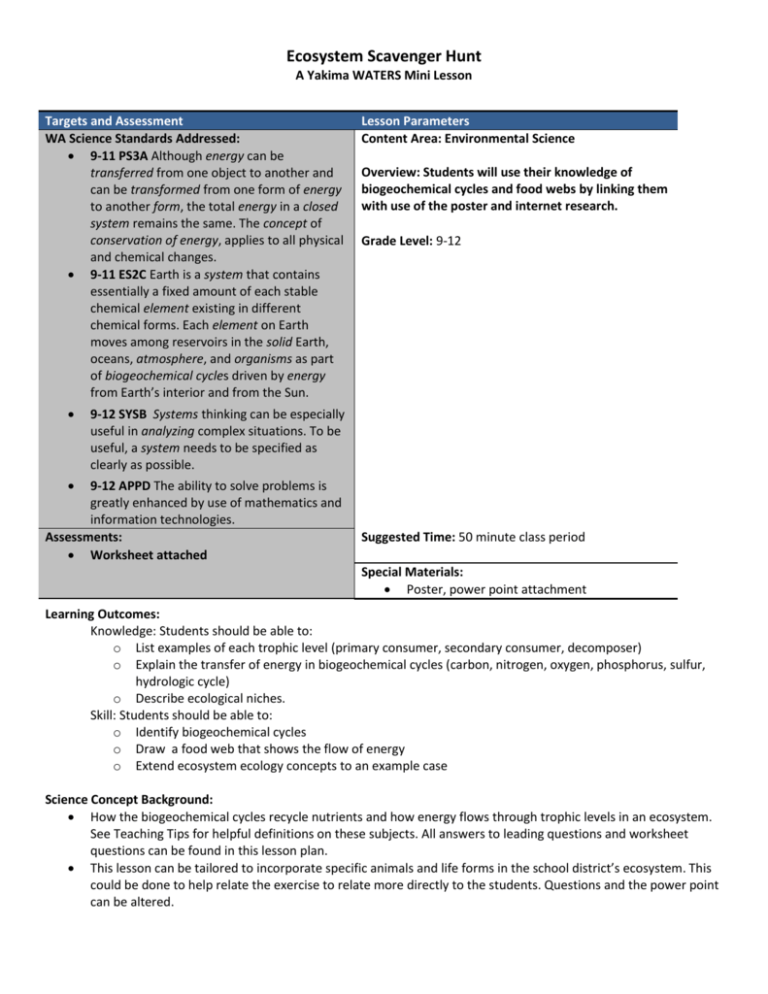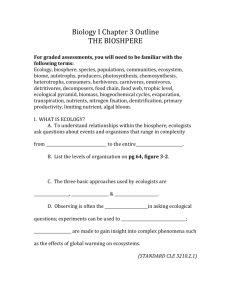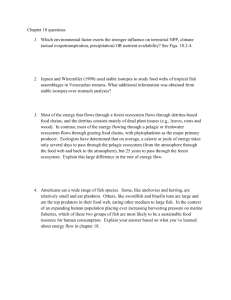Ecosystem Scavenger Hunt
advertisement

Ecosystem Scavenger Hunt A Yakima WATERS Mini Lesson Targets and Assessment WA Science Standards Addressed: 9-11 PS3A Although energy can be transferred from one object to another and can be transformed from one form of energy to another form, the total energy in a closed system remains the same. The concept of conservation of energy, applies to all physical and chemical changes. 9-11 ES2C Earth is a system that contains essentially a fixed amount of each stable chemical element existing in different chemical forms. Each element on Earth moves among reservoirs in the solid Earth, oceans, atmosphere, and organisms as part of biogeochemical cycles driven by energy from Earth’s interior and from the Sun. Lesson Parameters Content Area: Environmental Science Overview: Students will use their knowledge of biogeochemical cycles and food webs by linking them with use of the poster and internet research. Grade Level: 9-12 9-12 SYSB Systems thinking can be especially useful in analyzing complex situations. To be useful, a system needs to be specified as clearly as possible. 9-12 APPD The ability to solve problems is greatly enhanced by use of mathematics and information technologies. Assessments: Worksheet attached Suggested Time: 50 minute class period Special Materials: Poster, power point attachment Learning Outcomes: Knowledge: Students should be able to: o List examples of each trophic level (primary consumer, secondary consumer, decomposer) o Explain the transfer of energy in biogeochemical cycles (carbon, nitrogen, oxygen, phosphorus, sulfur, hydrologic cycle) o Describe ecological niches. Skill: Students should be able to: o Identify biogeochemical cycles o Draw a food web that shows the flow of energy o Extend ecosystem ecology concepts to an example case Science Concept Background: How the biogeochemical cycles recycle nutrients and how energy flows through trophic levels in an ecosystem. See Teaching Tips for helpful definitions on these subjects. All answers to leading questions and worksheet questions can be found in this lesson plan. This lesson can be tailored to incorporate specific animals and life forms in the school district’s ecosystem. This could be done to help relate the exercise to relate more directly to the students. Questions and the power point can be altered. Materials: Power Point of background information (slides are at end of lesson), Washington department of Fish and Wildlife “Washington’s Sea Stack Shoreline” poster and assessment worksheet (end of lesson). One poster and worksheet should be printed per student in the classroom. Procedure: First, ask the class what they already know about coral reefs. Then, access the first power point slide. Give the students an example of trophic levels and ecological niches that may take place in a system like this. Next, ask the class the following leading questions in reference to the power point slides located at the end of this lesson plan. This will take about 10 minutes. More time can be allotted for questions if the instructor feels it is necessary. Question: What is an example of a biogeochemical cycle that is happening in this coral reef picture? Answer: Could be Hydrologic cycle or Carbon cycle etc. Question: Does this fish in the picture have an ecological niche? Answer: Yes, one of its specific niches could be its bright coloring to blend in with its habitat of colorful coral reefs. Question: Is the fish a primary consumer, secondary consumer or a decomposer? Answer: the fish is most likely a primary consumer although some fish could be secondary consumers. Divide students into groups of 4. Once in groups, give each group a copy of the “Washington’s Sea Stack Shore Line” poster, and give each student a copy of the Ecosystem Scavenger hand out. Let the students answer the work sheet by using the poster. Incorporate formative assessment by asking your students how they are doing on the hand out, or by walking around the classroom and checking their progress from time to time. This exercise will take the rest of the class period. A summative assessment will be done once the hand outs are collected at the end of the lesson. The summative assessment should be done by grading the completed work sheet. The work sheet as is should be worth 20 points (6 points for the first question, 4 points for the second question, 4 points for the third question, 6 points for the fourth question). The instructor can adapt the work sheet and distribute points as needed for the individual classroom scenario. Extension(s): This lesson could be extended by researching oceanic food webs on the internet and then having the students compile more complex food webs. Teaching Tips: Helpful website: "NOAA coral reef conservation program." National Ocean Service, 26/07/2011. Web. 5 Dec 2011. <http://coralreef.noaa.gov/>. Helpful definitions: Coral Reefs- formed by massive colonies containing billions of tiny coral animals called Polyps. Polyps secrete a stony substance called Calcium Carbonate around them for protection. When the corals die, their empty outer skeletons form layers which cause the reefs to grow. They are found in coastal zones of warm tropical oceans. Biogeochemical cycles- natural processes that recycle nutrients in various chemical forms from the nonliving environment to the living environment and then back to the nonliving environment. Ecological Niche- The role of a species in an ecosystem. This includes all physical, chemical and biological conditions that a species needs to live and reproduce in an ecosystem. Trophic Levels- All organisms that are the same number of energy transfers away from the original source of energy that enters the ecosystem. This original source of energy is usually the sun. o Producers- Belong to the first trophic level o Primary Consumers- Belong to the 2nd trophic level. These organisms are herbivores so they feed on plants. o Secondary Consumers- Organisms that feed only on primary consumers o Decomposers- Organisms that digest dead organisms and wastes of living organisms by breaking down the organic molecules in those materials. Most chemicals get returned to the soil and water for reuse. By: Jessica Giblin, Fall 2011, for Ellensburg High School Worksheet questions for Ecosystem Scavenger Hunt for Environmental Science: 1) Identify a biogeochemical cycle that is occurring in the poster. Explain which cycle you found and what is happening. Please use at least three sentences. 2) List an example of each. The organism could be located in Washington’s ocean or at the shore line. a. Primary Consumerb. Secondary Consumerc. Tertiary consumerd. Decomposere. Producer3) Pick a species that you find most interesting. What do you suppose that specie’s niche is? 4) Draw a food web of the coastal ecosystem below. Include 5 organisms, and arrows to show how the energy is flowing. Answers 1) Students could answer with any of the biogeochemical cycles, as long as they provide a three sentence explanation to support their choice. 2) Producer- algae, coral, kelp Primary consumer- some species of insects, birds, shrimp and snails Secondary consumer- seals, some species of fish, pelican Tertiary consumer- eagle, sea lion, killer whale Decomposer- worms, bacteria, fungi 3) Student could answer with any species in the picture, as long as they support their answer by describing the niche of that species. 4) Food chain example: plankton -> shrimp -> fish -> sea lion -> fungi. Any combination of at least one organism for each trophic level is acceptable. • PRIMARY • SECONDARY DECOMPOSERS









